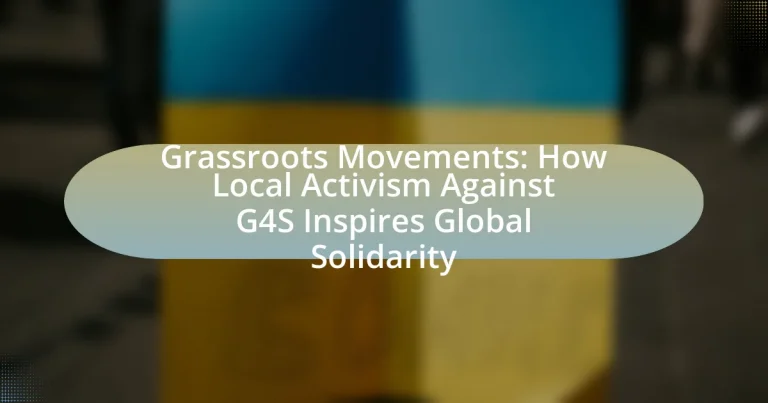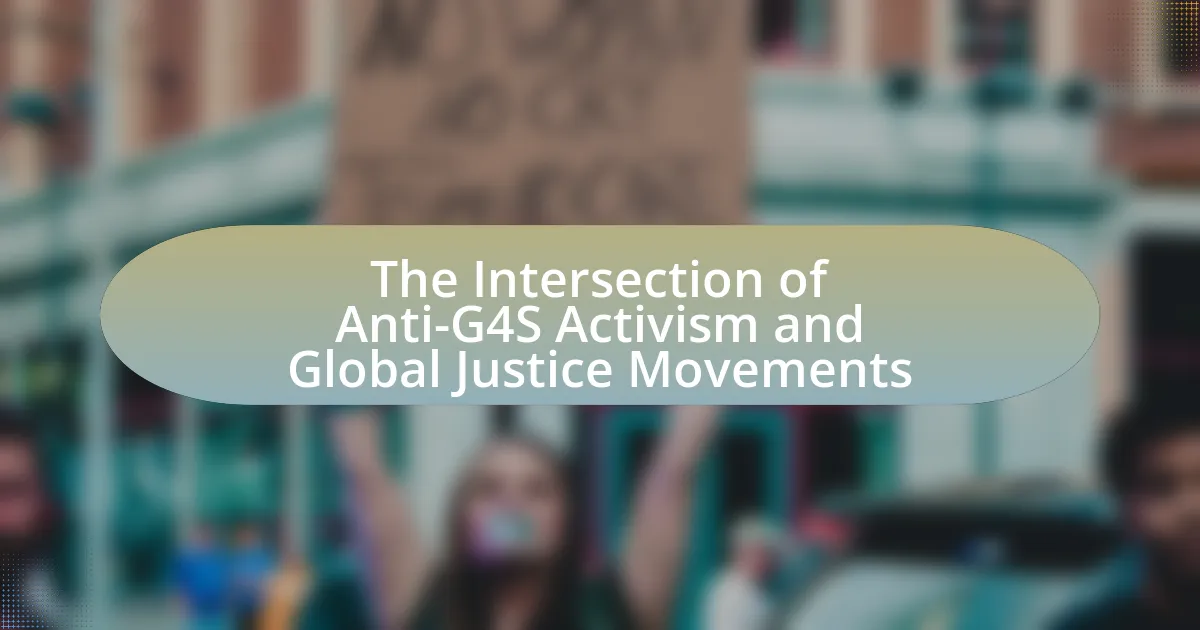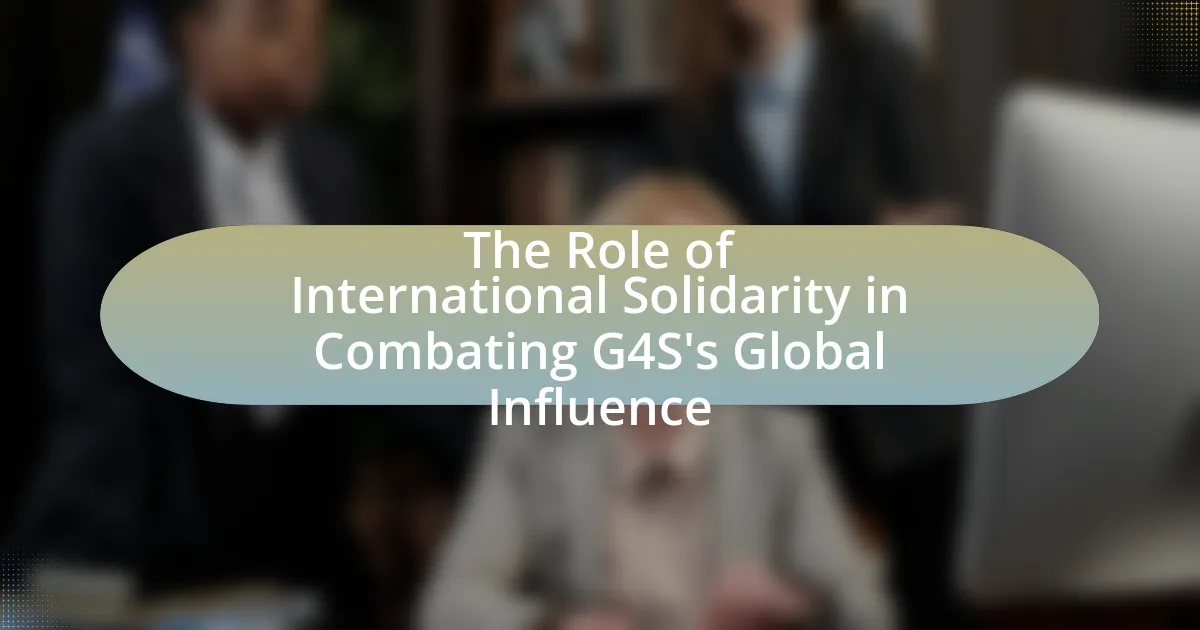Grassroots movements are community-driven initiatives that mobilize individuals to advocate for social change, particularly in the context of activism against G4S, a multinational security company criticized for human rights violations. These movements differ from traditional activism by emphasizing local participation and decentralized structures, allowing communities to address specific issues effectively. The article explores the characteristics and effectiveness of grassroots movements, the specific grievances against G4S, and the strategies employed by local activists to raise awareness and mobilize support. It also discusses the challenges faced by these movements and the importance of global solidarity in amplifying local efforts, highlighting how local activism can inspire broader movements and foster international cooperation for social justice.
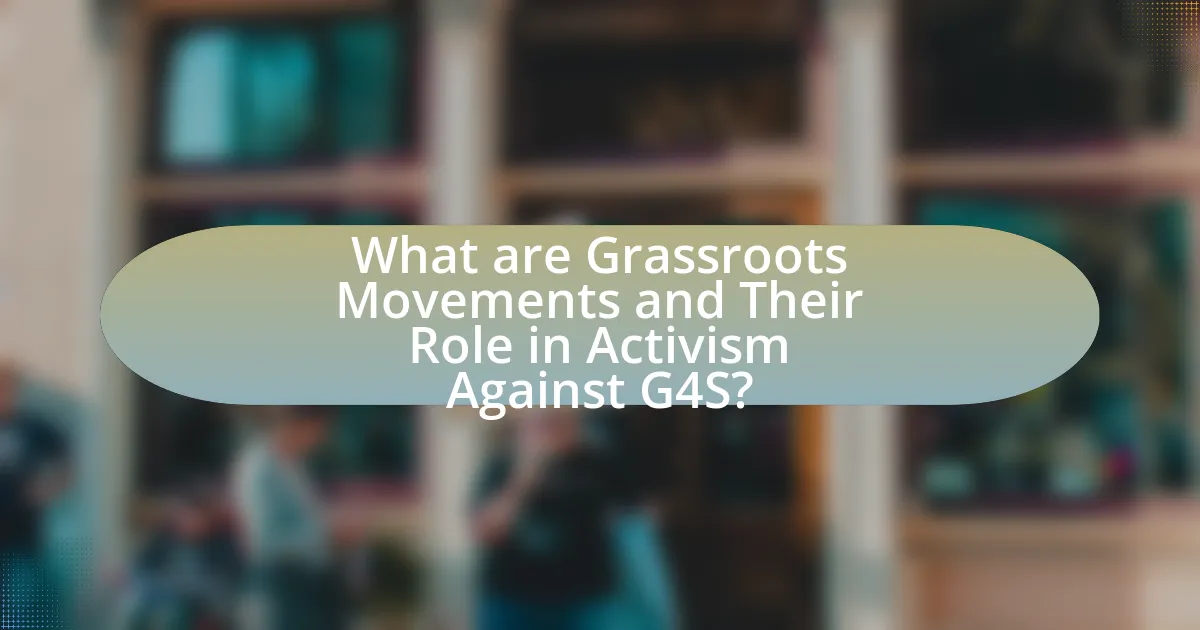
What are Grassroots Movements and Their Role in Activism Against G4S?
Grassroots movements are community-driven initiatives that mobilize individuals at the local level to advocate for social change, often focusing on issues like human rights, environmental justice, and corporate accountability. In the context of activism against G4S, a multinational security company criticized for its involvement in human rights violations, grassroots movements play a crucial role by raising awareness, organizing protests, and fostering community solidarity. For instance, campaigns such as “Boycott G4S” have emerged from local groups, effectively pressuring institutions to sever ties with the company, thereby amplifying the message of accountability and justice on a global scale. This localized activism not only challenges G4S’s practices but also inspires similar movements worldwide, demonstrating the power of collective action in addressing systemic issues.
How do Grassroots Movements differ from traditional activism?
Grassroots movements differ from traditional activism primarily in their structure and approach, with grassroots movements being community-driven and decentralized, while traditional activism often relies on established organizations and hierarchical frameworks. Grassroots movements mobilize local communities to address specific issues, fostering direct participation and ownership among members, as seen in various local campaigns against corporations like G4S. In contrast, traditional activism typically involves larger organizations that may prioritize broader agendas and utilize formal channels for advocacy, which can sometimes lead to a disconnect from the immediate concerns of local communities. This distinction highlights how grassroots movements can inspire global solidarity by emphasizing localized action and community engagement, as evidenced by the widespread support for local initiatives that challenge corporate practices.
What are the key characteristics of Grassroots Movements?
Grassroots movements are characterized by their community-driven nature, emphasizing local participation and activism. These movements typically arise from the collective efforts of individuals who share common interests or grievances, often focusing on social, political, or environmental issues. They rely on grassroots organizing, which involves mobilizing community members to advocate for change, often without formal leadership structures. Additionally, grassroots movements prioritize inclusivity and democratic decision-making, ensuring that all voices within the community are heard and represented. Evidence of their effectiveness can be seen in various historical examples, such as the Civil Rights Movement in the United States, where local activists played a crucial role in advocating for social justice and equality.
Why are Grassroots Movements effective in local contexts?
Grassroots movements are effective in local contexts because they are rooted in the specific needs and experiences of the community they represent. This localized focus allows them to mobilize individuals who are directly affected by the issues at hand, fostering a sense of ownership and urgency. For instance, the success of the Black Lives Matter movement in various U.S. cities demonstrates how grassroots activism can address local injustices, leading to tangible policy changes and community engagement. Additionally, research shows that grassroots movements often utilize social networks and local knowledge, which enhances their ability to organize and advocate effectively.
What specific issues are Grassroots Movements addressing regarding G4S?
Grassroots movements are addressing issues related to G4S’s involvement in human rights violations, particularly in the context of its operations in Palestine and its role in immigration detention centers. Activists highlight G4S’s complicity in the Israeli occupation, citing reports from organizations like Human Rights Watch that document abuses against Palestinians. Additionally, grassroots efforts focus on the ethical implications of G4S’s contracts with governments for managing detention facilities, where allegations of mistreatment and inadequate conditions have been reported. These movements aim to raise awareness and mobilize public opposition against G4S’s practices, advocating for accountability and justice.
How does G4S impact local communities?
G4S impacts local communities primarily through its security services, which can enhance safety but also lead to concerns about militarization and community relations. The presence of G4S in various regions often results in increased surveillance and policing, which some community members view as a necessary measure for safety, while others perceive it as an infringement on civil liberties. For instance, in areas where G4S operates, reports indicate a rise in tensions between security personnel and local residents, particularly in marginalized communities. This duality of impact fosters grassroots activism, as local groups mobilize against perceived injustices associated with G4S’s operations, advocating for more community-oriented approaches to safety and security.
What are the main grievances against G4S from activists?
Activists primarily criticize G4S for its involvement in human rights abuses, particularly in relation to its contracts with governments and institutions that operate in conflict zones or have controversial practices. Specific grievances include allegations of complicity in the Israeli occupation of Palestinian territories, where G4S has provided security services to facilities such as prisons and checkpoints, leading to accusations of supporting oppressive measures against Palestinians. Additionally, activists highlight G4S’s role in the privatization of public services, which they argue undermines accountability and can lead to mistreatment of vulnerable populations, such as migrants and detainees. These concerns are often supported by reports from human rights organizations that document instances of abuse and systemic issues within G4S’s operations.
How do local activists mobilize against G4S?
Local activists mobilize against G4S through organized protests, community outreach, and strategic partnerships with other organizations. These activists often utilize social media platforms to raise awareness about G4S’s controversial practices, such as its involvement in immigration detention and security services in conflict zones. For instance, campaigns like “Boycott G4S” have gained traction, encouraging consumers and institutions to sever ties with the company. Additionally, local groups often collaborate with international human rights organizations to amplify their message and create a broader coalition against G4S’s operations. This grassroots mobilization has been effective in drawing public attention and influencing policy discussions regarding the company’s role in various social issues.
What strategies do local activists employ to raise awareness?
Local activists employ various strategies to raise awareness, including community organizing, social media campaigns, and public demonstrations. Community organizing involves mobilizing residents to participate in discussions and actions that highlight local issues, fostering a sense of collective responsibility. Social media campaigns leverage platforms like Twitter and Facebook to disseminate information rapidly, engage a wider audience, and create viral content that draws attention to specific causes. Public demonstrations, such as protests or rallies, serve to visually represent the movement, attract media coverage, and galvanize public support. These strategies are effective as they create a multi-faceted approach to awareness, combining direct engagement with broader outreach efforts.
How do community organizing efforts contribute to activism against G4S?
Community organizing efforts significantly enhance activism against G4S by mobilizing local communities to raise awareness and challenge the company’s practices. These grassroots initiatives often involve coalition-building, where diverse groups unite to address shared concerns about G4S’s involvement in controversial activities, such as immigration enforcement and private prison management. For instance, campaigns like “Boycott G4S” have emerged from community organizing, effectively pressuring institutions to sever ties with the company. This collective action not only amplifies local voices but also fosters a sense of solidarity that can inspire similar movements globally, as seen in various international protests against G4S’s operations.
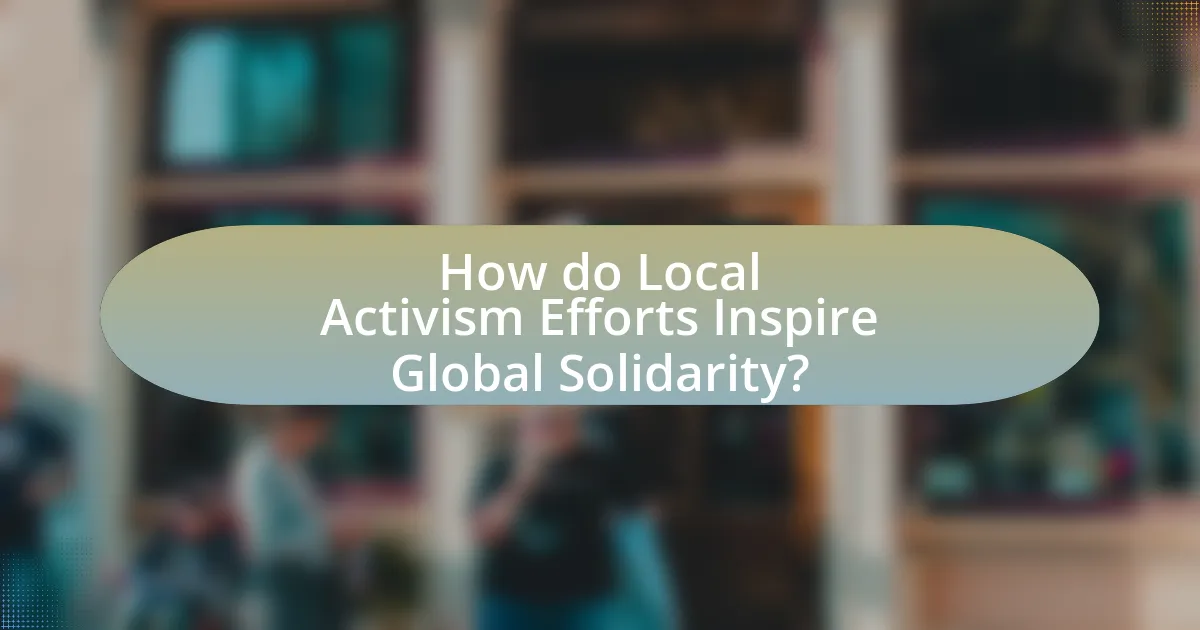
How do Local Activism Efforts Inspire Global Solidarity?
Local activism efforts inspire global solidarity by demonstrating the interconnectedness of social justice issues and mobilizing support across borders. For instance, grassroots movements against G4S, a multinational security company, have highlighted human rights violations in various contexts, prompting international awareness and action. The Boycott, Divestment, Sanctions (BDS) movement against G4S, which has been linked to the Israeli occupation of Palestinian territories, showcases how local campaigns can galvanize global support, leading to widespread advocacy and pressure on corporations and governments. This interconnected activism fosters a sense of shared responsibility and collective action, reinforcing the idea that local struggles resonate on a global scale.
What examples exist of local activism against G4S leading to global movements?
Local activism against G4S has led to global movements, notably through campaigns such as the Boycott, Divestment, Sanctions (BDS) movement, which emerged from grassroots efforts in Palestine. Activists in Palestine have highlighted G4S’s role in providing security services to Israeli prisons and checkpoints, prompting international solidarity actions. For instance, protests in the UK and South Africa against G4S contracts have garnered attention, leading to broader campaigns that call for divestment from companies associated with human rights violations. These local actions have inspired global networks, resulting in coordinated efforts to pressure institutions and governments to sever ties with G4S, demonstrating the interconnectedness of local activism and global movements.
How have social media platforms facilitated global solidarity?
Social media platforms have facilitated global solidarity by enabling real-time communication and mobilization among diverse groups worldwide. These platforms allow activists to share information, coordinate actions, and amplify their messages across borders, fostering a sense of shared purpose. For instance, during the Black Lives Matter movement, social media played a crucial role in uniting individuals globally, leading to widespread protests and support for racial justice initiatives. The hashtag #BlackLivesMatter trended internationally, demonstrating how social media can connect local struggles to a global audience, thereby enhancing collective action and solidarity.
What role do international organizations play in supporting local movements?
International organizations play a crucial role in supporting local movements by providing resources, advocacy, and a platform for global visibility. These organizations often offer financial assistance, technical expertise, and training to grassroots activists, enabling them to enhance their capacity and effectiveness. For instance, organizations like Amnesty International and Human Rights Watch amplify local voices by documenting human rights abuses and mobilizing international pressure, which can lead to policy changes. Additionally, international organizations facilitate networking opportunities, connecting local movements with global allies, thereby fostering solidarity and shared strategies. This support is vital for local movements to gain traction and achieve their objectives on a larger scale.
Why is global solidarity important for local movements?
Global solidarity is important for local movements because it amplifies their impact and provides essential resources and support. When local movements receive backing from a global network, they gain visibility, which can attract media attention and public interest, thereby increasing their influence. For instance, the global response to the Black Lives Matter movement has shown how local issues can resonate worldwide, leading to broader advocacy for racial justice. Additionally, global solidarity can facilitate the sharing of strategies and best practices, enabling local movements to learn from each other and adapt successful tactics. This interconnectedness strengthens the overall fight against systemic injustices, as seen in various campaigns against corporations like G4S, where local actions are bolstered by international awareness and solidarity.
How does global support amplify local activist voices?
Global support amplifies local activist voices by providing resources, visibility, and a broader platform for their messages. When international organizations and communities rally behind local movements, they enhance the reach of local activists, allowing their issues to gain attention on a global scale. For instance, campaigns like the Boycott, Divestment, Sanctions (BDS) movement against G4S have shown that solidarity from global allies can lead to increased media coverage and pressure on local governments and corporations. This interconnectedness not only validates local struggles but also mobilizes additional support, creating a more formidable force for change.
What are the potential risks of globalizing local movements?
Globalizing local movements poses several potential risks, including the dilution of local identities and priorities. When local movements are globalized, they may lose their unique cultural context and specific goals, leading to a one-size-fits-all approach that does not address local needs effectively. Additionally, global attention can attract external influences that may not align with the original movement’s values, potentially compromising its integrity. For instance, the Black Lives Matter movement, while gaining international support, has faced challenges in maintaining its grassroots focus amid varying interpretations and agendas in different countries. This illustrates how globalizing a local movement can lead to fragmentation and misrepresentation of its core message.

What are the Challenges Faced by Grassroots Movements Against G4S?
Grassroots movements against G4S face several challenges, including limited resources, lack of media coverage, and systemic opposition. Limited financial and human resources hinder their ability to mobilize effectively and sustain campaigns. Additionally, mainstream media often overlooks these movements, reducing their visibility and impact. Systemic opposition from G4S, which includes legal actions and lobbying efforts, further complicates their efforts to advocate for change. These challenges collectively impede the effectiveness and reach of grassroots activism against G4S.
What obstacles do local activists encounter in their efforts?
Local activists encounter several obstacles in their efforts, including limited funding, lack of media coverage, and governmental resistance. Limited funding restricts their ability to organize events, conduct outreach, and sustain campaigns, as many rely on small donations or volunteer support. Lack of media coverage diminishes their visibility and the impact of their messages, making it challenging to garner public support. Governmental resistance often manifests through legal challenges, restrictions on protests, or surveillance, which can intimidate activists and hinder their activities. These factors collectively impede the effectiveness of local activism, as evidenced by numerous reports highlighting the struggles faced by grassroots movements in various regions.
How do legal and political barriers affect grassroots activism?
Legal and political barriers significantly hinder grassroots activism by restricting the ability of activists to organize, communicate, and mobilize effectively. For instance, laws that impose strict regulations on public gatherings can limit the capacity of grassroots movements to hold protests or rallies, thereby stifling their visibility and impact. Additionally, political repression, such as surveillance or intimidation by authorities, can create a climate of fear that discourages participation and undermines collective action. Historical examples include the Civil Rights Movement in the United States, where activists faced legal challenges and violent opposition, yet persisted in their efforts, demonstrating that while barriers exist, they can also galvanize support and solidarity among diverse groups.
What challenges arise from community division or apathy?
Community division or apathy leads to weakened social cohesion and reduced collective action. When individuals within a community are divided, they often struggle to unite around common goals, which hampers grassroots movements aimed at addressing issues like those posed by G4S. A study by the Pew Research Center indicates that communities with high levels of division experience lower levels of civic engagement, which directly impacts the effectiveness of local activism. Additionally, apathy can result in a lack of participation in decision-making processes, further entrenching systemic issues and diminishing the potential for meaningful change.
How can grassroots movements overcome these challenges?
Grassroots movements can overcome challenges by fostering strong community engagement and leveraging digital platforms for wider outreach. Engaging local communities builds trust and mobilizes support, as seen in successful campaigns like the Fight for $15, which united fast-food workers across the U.S. to advocate for higher wages. Additionally, utilizing social media allows grassroots movements to amplify their message, connect with allies globally, and share resources effectively, as demonstrated by the #MeToo movement, which gained international traction through online platforms. These strategies enable grassroots movements to navigate obstacles and create impactful change.
What strategies have proven effective in building community support?
Effective strategies for building community support include fostering inclusive dialogue, leveraging social media for outreach, and organizing community events. Inclusive dialogue encourages participation from diverse community members, ensuring that various perspectives are heard and valued, which strengthens community ties. Social media serves as a powerful tool for disseminating information quickly and mobilizing support, as evidenced by campaigns that have successfully engaged thousands of participants in local activism. Organizing community events, such as workshops or rallies, creates opportunities for face-to-face interaction, enhancing relationships and solidarity among community members. These strategies have been validated by numerous grassroots movements that have successfully mobilized local support against larger entities, demonstrating their effectiveness in fostering community engagement and solidarity.
How can activists leverage partnerships to strengthen their efforts?
Activists can leverage partnerships to strengthen their efforts by collaborating with organizations that share similar goals, thereby amplifying their reach and resources. For instance, partnerships with local NGOs can provide activists access to funding, expertise, and networks that enhance their campaigns. A notable example is the collaboration between grassroots movements and international human rights organizations, which has historically increased visibility and support for local issues, as seen in the global response to the anti-apartheid movement. This synergy not only fosters solidarity but also mobilizes a broader audience, making campaigns more effective and impactful.
What practical steps can individuals take to support grassroots movements against G4S?
Individuals can support grassroots movements against G4S by actively participating in local campaigns, raising awareness through social media, and donating to organizations that oppose G4S’s practices. Engaging in local campaigns allows individuals to contribute directly to efforts that challenge G4S’s operations, while social media serves as a powerful tool to amplify messages and mobilize support. Donations to relevant organizations can provide essential resources for advocacy and outreach efforts. For instance, campaigns like “Stop G4S” have successfully mobilized communities and garnered international attention, demonstrating the impact of grassroots activism.
How can community members get involved in local activism?
Community members can get involved in local activism by participating in grassroots organizations that focus on specific social issues. Engaging with local groups allows individuals to collaborate on initiatives, attend meetings, and volunteer for events that promote awareness and action. For instance, organizations like the American Civil Liberties Union (ACLU) and local chapters of national movements often provide structured opportunities for community involvement, such as rallies, educational workshops, and advocacy campaigns. Research indicates that grassroots movements can significantly influence public policy and community engagement, as seen in the success of local campaigns against corporations like G4S, which have sparked broader global solidarity efforts.
What resources are available for those looking to support these movements?
Resources available for supporting grassroots movements against G4S include online platforms for donations, social media campaigns for awareness, and local activist organizations that provide volunteer opportunities. Websites like GoFundMe and Patreon facilitate financial contributions directly to activists and initiatives. Social media platforms such as Twitter and Facebook serve as tools for spreading awareness and mobilizing support through hashtags and campaigns. Additionally, organizations like the International Coalition for Human Rights in the Philippines and local chapters of Amnesty International offer structured ways to engage, volunteer, and contribute to advocacy efforts. These resources enable individuals to actively participate in and support movements aimed at promoting social justice and human rights.
